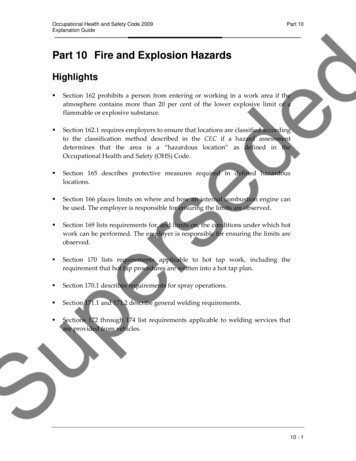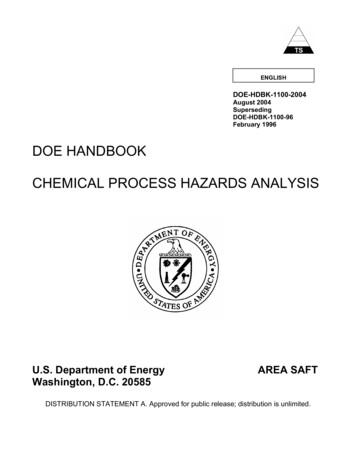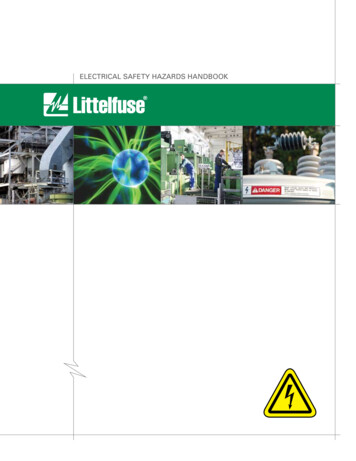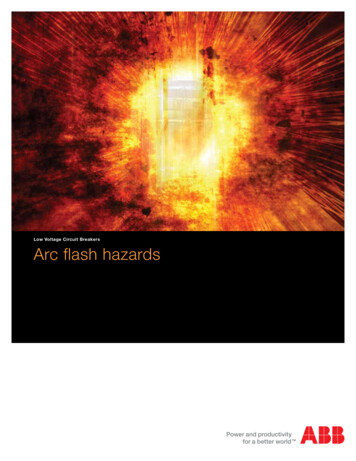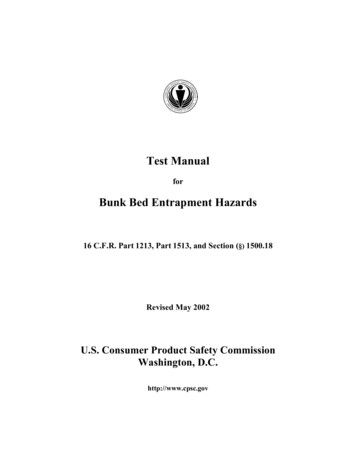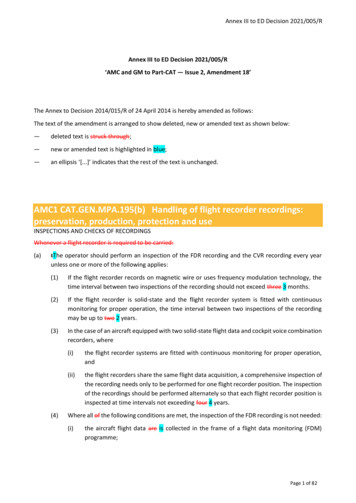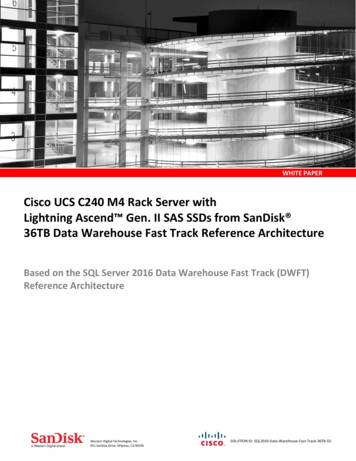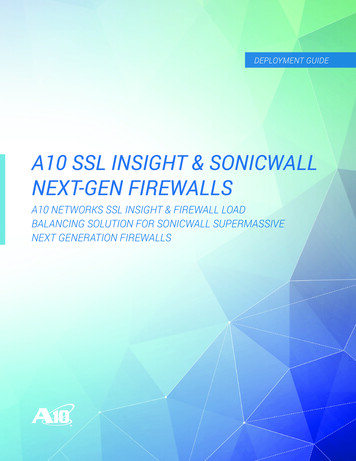
Transcription
Electrocution Hazards1Electricity AccidentsPeople who work directly or indirectly with electricity can be the victims of seriouselectrocution injury or death on construction sites. These accidents occur when: Construction equipment comes into contact with high power lines.Wires are not properly insulated.Wires are not properly moved or labeled during work.Electricity is not turned off before work begins.Workers do not know the location of underground power lines.Workers do not ask local utility companies for power line information.2Types of Electrocution HazardsThe Occupational Safety and Health Administration (OSHA) recognizes electricity as aserious workplace hazard and implemented electrical standards to protect employeesexposed to dangers such as electric shock, electrocution, fires, and explosions.Electrocution results when a person is exposed to a lethal amount of electrical energy. Anelectrical hazard can be defined as a serious workplace hazard that exposes workers toany of the following: Burns Electrocution Shock Arc flash or arc blast Fire Explosions31
Types of Health Hazards (cont.)TermsBurnsElectrocutionShockArc Flash or ArcBlastFireExplosionsHazard DefinitionMost common shock-related injury resulting in electrical, arc flash, or thermal contactinjuries.Means to kill with electricity and occurs when a person is exposed to a lethal amount ofelectrical energy.A reflex response to the passage of electric current through the human body and resultswhen electric current enters the body at one point and leaves through another.Sudden release of electrical energy through the air that gives off thermal radiation (heat)and bright, intense light that can cause burns. Temperatures have been recorded as highas 35,000 F.Fixed wiring, such as faulty electrical outlets and old wiring, is the most common cause.Problems with extension and appliance cords, plugs, receptacles, and switches are alsoresponsible.Can occur when electricity ignites an explosive mixture of materials in the air.4Leading Causes of Construction IndustryDeathsIn 2005, the BLS concluded that: Electrocution was the fourth leading cause of construction deaths causing 9% of 1,243t ti workerk deaths,d th bbutt accountedt d forf lesslththan 1% off reportedt d recordabled bl non-fatalf t lconstructioninjuries. From 2003-2005, the death rate from electrocutions for the construction industry was 1.1 per100,000 full-time workers, an average of 121 electrocutions per year. Electrical power installers, repairers, and earth drillers had the highest electrocution deathrates. The construction occupations with the highest number of electrocution deaths were: Electricians (29) Construction laborers (19) Supervisors and managers (13) Electrical power installers and repairers (10)5Electrocution DangersThe most common electrocution dangers in the constructionindustry are: Contacting overhead power lines. Contacting energized sources, such as live parts, damaged orbare wires, defective equipment, or tools. Using extension or flexible cords improperly.62
Electrocution Dangers (cont)DangerOverhead PowerLinesEnergized SourcesImproper Use ofCordsDescriptionOverhead and buried power lines are especially dangerous to workers because they carryextremely high voltage ranging from 120 to 750,000 volts. The most reliable way to know apower line’s voltage is to ask the utility company that owns the line.Electrical shock and burns are the major dangers from contact with energized sources. Electricalshock happens when an individual comes in contact with both wires of an electrical circuit one wire of an energized circuit and the ground, or a metallic part that is energized by contact with an electrical conductor.Flexible extension cords are more susceptible to damage than fixed wiring because they areexposed and unsecured. Workers create hazards when cords, cord connectors, receptacles,and cord- and plug-connected equipment are not used and maintained properly.7Contact with Overhead Power LinesPeople working in the vicinity of high voltage power lines are exposedto burns, falls from elevations, and fatalities due to electrocution.g onWorkers often encounter electrocution hazards while workingcranes, ladders, man-baskets, or other equipment under or near powerlines.Some overhead power lines have a protective covering. Although, thiscovering protects power lines from exposure to the elements, it doesnot protect workers from electrocution. If you touch a power line,covered or bare, death is possible.8Contact with Energized SourcesElectrical shock results when the body becomes part of the electricalcircuit and current enters the body at one point and leaves throughanother. The severity and effects of an electrical shock depend onthe following:––––Pathway through the bodyAmount of currentLength of time of the exposurePresence of water on the skin because water is a great conductor of electricity,allowing current to flow more easily in wet conditions and through wet skin93
Contact with Energized Sources (cont)Electrical burns are among the most serious burns and require immediate medicalattention. They occur when an electric current flows through tissue or bone, generatingheat that causes tissue damage. Because the body cannot dissipate the heat generatedby current flowing through the resistance of the tissuetissue, burns occuroccur.Arc or flash burns are caused by an electric arc or explosion. An arc flash, or blast, is ashort circuit through the air where the electricity flashes over from one exposed liveconductor to another conductor or to ground. A nearby person can act as the conductorand be flash burned.Like most contact burns, thermal contact burns occur when skin comes in contact with hotequipment.10Improper Use of Extension and Flexible CordsFlexible cords can be damaged by:––––––Door or window edgesStaplesFasteningsAbrasions fromfadjacent materialsAgingMoisture When a cord connector is wet, electric current can leak to the equipment grounding conductor,and to anyone who picks up that connector, if they provide a path to ground. Such leakage canoccur on the face or a moist portion of the connector. When cords are damaged, electrical conductors can become exposed increasing the danger ofshocks, burns, or fire. To reduce hazards, flexible cords must connect to devices and fittings inways that prevent tension at joints and terminal screws.11Electrocution Safety MethodsTo help you StartSafe and StaySafe when working with electricity, youshould always:–––––Maintain a safe distance from overhead power lines.Use ground-fault circuit interrupters.Inspect extension cords and portable tools.Use power tools and equipment as designed.Follow proper lockout/tagout procedures.124
Safety Practices for Working Near Power LinesStaying as far away from power lines as possible is the best way to avoid being electrocuted. Thefollowing table shows the safe power line clearance distance for various line voltages.Voltage(nominal, kV, alternating current)50 or lessOver 50 to 200Over 200 to 350Over 350 to 500Over 500 to 750Over 750 to 1000Over 1000Minimum Clearance Distance(feet)101520253545Established by the power line owner,operator, or registered engineer who isqualified to assess electrical powertransmission and distribution13Using Ground Fault Circuit InterruptersA ground fault circuit interrupter (GFCI) is designed to protect people from severeand sometimes fatal electrocution by: Monitoringg the current-to-load for leakageg to gground. Detecting when the leakage exceeds 5 mA 1 mA, which is a ground fault. Interrupting the flow of electric current by tripping quickly enough to preventelectrocution.In the scenario above, the GFCI would: Sense the current flowing through the worker. Trip the circuit. Cut off the electricity.14Using Ground Fault Circuit Interrupters (cont)Term Receptacle GFCI Temporary or PortableGFCICircuit Breaker GFCI DefinitionProtects users from ground faults when someone connects electrical equipment to aGFCI protected outlet.Fits into the standard outlet box.Used on outdoor construction work sites and locations where wet conditions do orcould exist.Workers should test after installation and once a month thereafter.Contains an extension cord combined with a GFCI.Allows workers to use receptacles not protected by GFCls.Used when permanent protection is not available.Workers should test before every use.Controls an entire circuit.Replaces a circuit breaker on the main circuit board.Protects the entire circuit eliminating the need to install multiple GFCI outlets.Protects specific circuits when installed in a panel box at work sites equipped withcircuit breakers.155
Inspecting Extension Cords and Portable ToolsEven when the power system is properly grounded, electrical equipment can instantly change from safe tohazardous due to extreme conditions or rough handling. Therefore, it is important that workers follow thesetool safety tips. Use only approved equipment.Use all equipment according to the manufacturer's instructions.Never carry a tool by the cord.Never yank the cord to disconnect a tool.Keep cords away from heat, oil, and sharp edges.Disconnect when not in use and when changing accessories such as blades and bits.Avoid accidental starting.Do not hold fingers on the switch while carrying a plugged-in tool.Use gloves and appropriate footwear.Store in dry a place when not in use.Do not use in wet or damp environments.Remove damaged tools from use.Use double-insulated tools.16Dangers of Working With Asbestos (cont)According to the Occupational Safety and Health Administration (OSHA), employersmust ensure that no employee is exposed to an airborne concentration of asbestos inexcess of:–––0.1 fiber pper cubic centimeter as an 8-hour time-weightedgaverageg ((TWA))AND1 fiber per cubic centimeter as averaged over a sampling period of 30 minutesTo help ensure the safety and health of workers around asbestos, employers must:–––Assess all asbestos operations for the potential to generate airborne fibers.Use exposure monitoring data to assess employee exposures.Designate a competent person to identify asbestos hazards in the workplace and correct them whenfound17Dangers of Working with SilicaCrystalline silica is a basic component of soil, sand, granite, and many otherminerals whose particles can be inhaled by workers chipping, cutting, drilling,or grinding objects that contain silica. There are three types of crystallinesilica:– Quartz is the most common form of crystalline silica– Cristobalite– Tridymite186
Dangers of Working with Silica (cont)Crystalline silica is classified as a human lung carcinogen that, wheninhaled, can cause silicosis, which can be disabling, or even fatal.Respirable silica dust enters the lungs and causes the formation ofscar tissue, thus reducing the lungs’ ability to take in oxygen. Becausethe effects of silica are irreversible, it is considered a serious healthhazard on many construction sites.Dust TypeRespirableCoarseDefinitionFine dust that workers inhale deeply into the lungs where it causes the most damageCaught in the nose and throat before reaching the lungs19Dangers of Working with Silica (cont)The legal limit for silica in the air is 100 micrograms per cubic meter. A general rule ofthumb is that if you can see dust containing silica in the air, it is almost, always over thepermissible limit. To help ensure you StartSafe and StaySafe when working around silicadust, you should: Be aware that smoking increases the damage from crystalline silica.Know the work operations where exposure to crystalline silica may occur.Participate in any air monitoring or training programs offered by an employer.Wear a respirator approved for protection against crystalline silica-containing dust, when necessary.Use Type CE positive pressure abrasive blasting respirators when sandblasting.Change into disposable or washable work clothes at the work site, if possible.Shower and change into clean clothing before leaving the work site, if possible.Avoid eating, drinking, using tobacco products, or applying cosmetics in areas crystalline silica dust.Wash hands and face before eating, drinking, smoking, or applying cosmetics outside of the exposurearea.20Following Proper Lockout/Tagout ProceduresMany accidents occur because workers fail to lockout and tagout machinery properly.Lockout and tagout (LOTO) or lock and tag is an essential safety procedure that protectsworkers from injury while working on or near electrical circuits and equipment becauseLOTO: Locks the device or power source and prevents the turning on of hazardous powersources while performing maintenance or servicing work. Requires workers to place a tag on the locked device indicating that it should not beturned on. When using a tag, other energy isolation techniques may be necessary tomaintain worker safety. Prevents contact with operating equipment parts such as, blades, gears, shafts, etc. Prevents the unexpected release of hazardous gases, fluids, or solid matter in areaswhere workers are present.217
Following Proper Lockout/Tagout Procedures (cont)Workers must follow LOTO procedures to protect against being electrocuted. When performing LOTO on circuitsand equipment, do the following: Identify all sources of electrical energy for the equipment or circuits in question.Disable backup energy sources, such as generators and batteries.Identify all shut-offs for each energy source.Notify all personnel that equipment and circuitry must be shut off, locked out, and tagged out because justturning a switch off is not enough.Shut off energy sources and lock switch gear in the OFF position. Each worker should use his or her individuallock and key and keep them on their person.Test equipment and circuitry to ensure they are de-energized. This must be done by a qualified, competentperson.Deplete stored energy by bleeding, blocking, or grounding.Apply a lock or tag to alert other workers that an energy source or piece of equipment has been locked ortagged out.Make sure all workers are safe and accounted for before equipment and circuits are unlocked and turned backon. Only a qualified person can determine when it is safe to re-energize circuits.22Employers’ Responsibilities for ProtectingWorkersOSHA expects employers to take every precaution to protect workers from electrocutionby: Ensuring overhead power line safety.Isolating electrical parts.Supplying ground-fault circuit Interrupters.Implementing an assured equipment grounding conductor program (AEGCP)Ensuring the safety of power tools.Ensuring proper guarding.Providing training.Enforcing LOTO safety-related practices.Ensuring proper use of flexible cords.23#1: Ensuring Overhead Power Line SafetyThe most important ways employers can minimize power line hazards are to: Maintain a safe distance from lines. Ask the power company to:o De-energize and ground power lines.o Keep a power company representative on sitesite.o Install insulated sleeves, known as eels, over power lines.Employers should also: Train workers about power line hazards and available protective measures. Inform workers about jobs with electrical hazards and how to control these risks. Encourage workers to ask questions if they have any doubts about maintaining safe workingconditions.248
#2: Isolating Electrical PartsEmployers are expected to: parts, conductors enteringg boxes, cabinets, and fittingsg from abrasion.Protect electrical pClose openings through which conductors enter.Close unused openings in cabinets, boxes, and fittings.Cover pull boxes, junction boxes, and fittings.Ground metal covers.Cover each outlet box, faceplate, or fixture canopy in energized installations.Install proper bushings or provide smooth, well-rounded surfaces for flexible cords to pass through.25#3: Supplying Ground-Fault Circuit InterruptersAccording to OSHA’s ground-fault protection rules and regulations, employersmust: Supply approved GFCIs on all 120-volt, single-phase, 15- and 20-amperereceptacle outlets on construction sites that are not a part of a building orstructure’s permanent wiring. Supply approved GFCIs for extension cords with receptacles. Install GFCI circuit breakers in the main circuit board to protect an entirecircuit.26#4: Implementing an Assured EquipmentGrounding Conductor ProgramPer OSHA’s requirements, employers must establish and implement an assured equipmentgrounding conductor program (AEGCP) that: Outlines specific procedures for inspecting and testing required equipmentequipment. Covers all cord sets, receptacles not part of a building or structure’s permanent wiring of the, and equipment usedby employees that is connected by a cord and plug. Records the outcomes of continuity tests that ensure the equipment grounding conductor is electricallycontinuous.Electrical equipment noted in the AEGCP must be visually inspected each day by a competent person for damage ordefects before use. Any damaged or defective equipment must not be used by the employee until it is repaired.Employers must make the written program description and recorded tests available, at the jobsite, to OSHA and anyaffected employee, upon request. The employer is required to designate one or more competent persons to implementthe program.279
#5: Ensuring the Safety of Power ToolsEmployers need to ensure that all power tools and equipment are safe forworkers to use by: Grounding power supply systemssystems, electrical circuitscircuits, and electrical equipmentequipment. Inspecting electrical systems frequently to ensure continuous path to ground. Verifying that ground prongs are present in tools or extension cords. Grounding exposed metal parts of equipment. Communicating to workers the importance of inspecting electrical equipmentbefore using.28#6: Ensuring Proper GuardingEffective guarding requires equipment with exposed parts operating at 50volts or more to be: Placed where they are accessible only to authorized people qualified towork with or on the equipment. Confined to ensure workers do not accidentally come into contact withthe equipment’s live parts. Enclosed in a room, vault, balcony, gallery, or elevated platform at leasteight feet above the floor.29#7: Providing TrainingAccording to OSHA, to help workers StartSafe and StaySafe, employers musttrain workers on the safety-related work practices that pertain to their jobassignments. Employers should instruct workers using electric equipment insafe work practices to: De-energize electric equipment before inspecting or repairing.Use cords, cables, and electric tools that are in good condition.Follow proper lock out tag out procedures.Use appropriate protective equipment.3010
#8: Enforcing LOTO Safety-Related PracticesRegarding lockout/tagout procedures, OSHA expects employers to: Lockout/tagout deactivated controls while working on energized or deenergized equipment or circuits. Attach tags on deactivated equipment or circuits at all points where theycan be energized. Attach tags to identify equipment or circuits being worked on while anyworker is exposed to contact with live parts.31#9: Ensuring Proper Use of Flexible CordsThe OSHA construction standard requires that flexible cords are: Rated for hard or extra-hard usage. Show the rating every foot along the length of the cord.Extension cords must be 3-wire type so they may be grounded, and to permitgrounding of any tools or equipment connected to them. Limit exposure ofconnectors and tools to excessive moisture by using watertight or sealableconnectors.32#9: Ensuring Proper Use of Flexible CordsThe OSHA construction standard requires that flexible cords are: Rated for hard or extra-hard usage. Show the rating every foot along the length of the cord.Extension cords must be 3-wire type so they may be grounded, and to permitgrounding of any tools or equipment connected to them. Limit exposur
The Occupational Safety and Health Administration (OSHA) recognizes electricity as a serious workplace hazard and implemented electrical standards to protect employees exposed to dangers such as electric shock, electrocution, fires, and explosions. 3 Electrocution results when a person is exposed to a lethal amount of electrical energy. AnFile Size: 343KB
